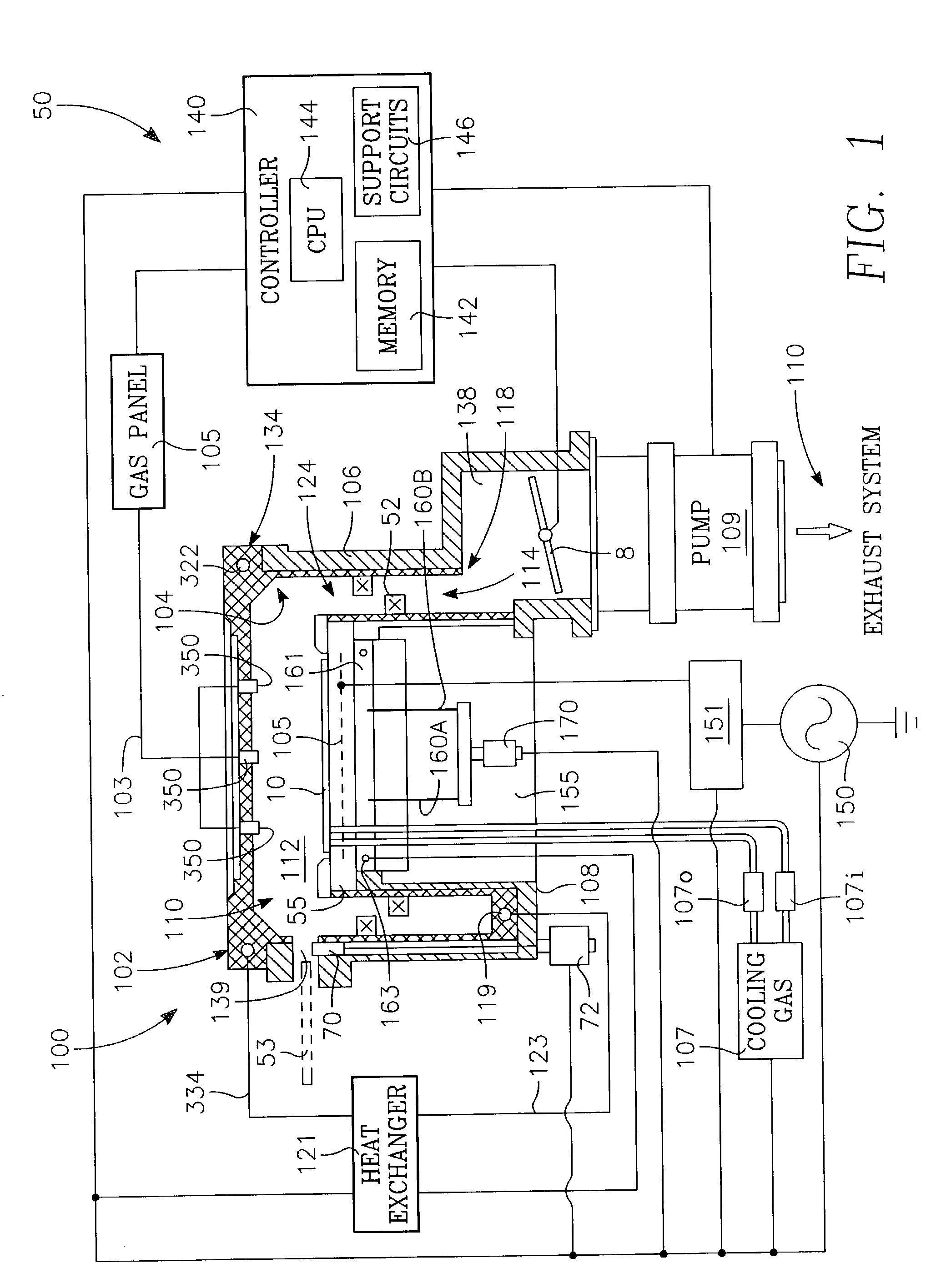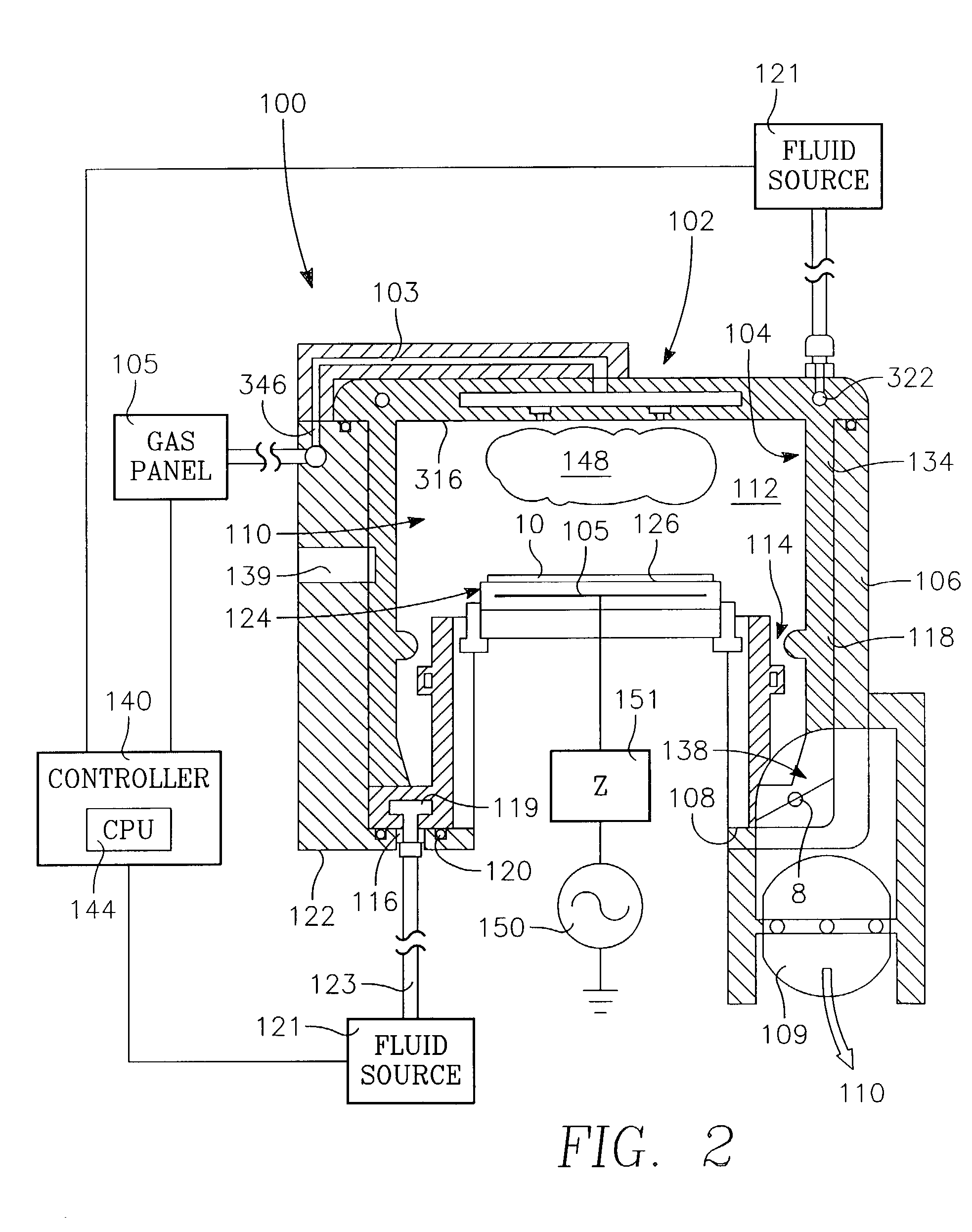Dielectric etch chamber with expanded process window
a technology of dielectric etching and process window, which is applied in the direction of coatings, solid-state devices, chemical vapor deposition coatings, etc., can solve the problems of etch reaction by-products forming deposits on the exposed chamber surface, shrinking critical dimensions quickly, and reducing the efficiency of etching, so as to improve the adhesion of reaction by-products, improve the adhesion of by-products, and improve the effect of reaction by-product formation
- Summary
- Abstract
- Description
- Claims
- Application Information
AI Technical Summary
Benefits of technology
Problems solved by technology
Method used
Image
Examples
example 1--
Pyramid Depressions in Aluminum Nitride Roof
[0130] We fabricated a chamber roof (gas distribution plate) as a circular disk of aluminum nitride ceramic, 0.5 inch (13 mm) thick, in which we divided the lower circular surface of the roof (the surface exposed to the chamber interior) into four quadrants, with four different surface textures fabricated in the four quadrants. The first quadrant was smooth, and the second quadrant was bead blasted with silicon carbide particles.
[0131] The third and fourth quadrants both had the pyramid texture 60a shown in FIG. 15, with bead blasting subsequently applied to the fourth quadrant but not the third. The dimensions of the pyramid features were: angle .theta.=45.degree., height H=0.6 mm, width W=1.5 mm, spacing S=0.6 mm. We calculate that the third quadrant had a surface area 30% greater than that of the first quadrant due to its pyramid texture.
1TABLE 1 Example 1 Quadrant Pyramid Texture Bead Blasting 1 No No 2 No Yes 3 Yes No 4 Yes Yes
[0132] ...
example 2--
Different Pyramid Dimensions in Aluminum Nitride Roof
[0135] A second aluminum nitride roof (gas distribution plate) was fabricated as described for Example 1. The four quadrants were textured with pyramids having different dimensions, as summarized in Table 1. In the first quadrant, the pyramid dimensions were identical to those of quadrant 3 of Example 1. In the other three quadrants, the height H of the pyramid depressions was increased to 1.1 mm. In quadrants 3 and 4, the angle .theta. of the pyramid walls relative to the horizontal surface was decreased to 30.degree.. In quadrants 2 and 4, the width W and spacing S were increased to 2.5 mm and 1.0 mm, respectively. All four quadrants exhibited no flaking of the polymer deposits.
2TABLE 2 Example 2 Quadrant Angle .theta. Height H Width W Spacing S 1 45.degree. 0.6 mm 1.5 mm 0.6 mm 2 45.degree. 1.1 mm 2.5 mm 1.0 mm 3 30.degree. 1.1 mm 1.5 mm 0.6 mm 4 30.degree. 1.1 mm 2.5 mm 1.0 mm
example 3--
Hemispherical Depressions in Aluminum Oxide Roof
[0136] We fabricated a roof of a 0.5 inch (13 mm) thick plate of aluminum oxide (alumina) ceramic. Alumina has a much lower thermal conductivity than aluminum nitride, but it has the advantage of being readily machinable. We created the pattern of depressions shown in FIGS. 16 and 17 by drilling in the alumina an array of approximately hemispherical holes, or holes having an arcuate cross section, having a hole diameter W of 4 mm and a spacing S between the perimeters of adjacent holes of 1 mm. We tested two prototypes in which the depth of the holes (the topographical feature height H) were 1 mm and 2 mm, respectively. Both prototypes exhibited no flaking of the polymer deposits.
PUM
| Property | Measurement | Unit |
|---|---|---|
| Time | aaaaa | aaaaa |
| Time | aaaaa | aaaaa |
| Volume | aaaaa | aaaaa |
Abstract
Description
Claims
Application Information
 Login to View More
Login to View More - R&D
- Intellectual Property
- Life Sciences
- Materials
- Tech Scout
- Unparalleled Data Quality
- Higher Quality Content
- 60% Fewer Hallucinations
Browse by: Latest US Patents, China's latest patents, Technical Efficacy Thesaurus, Application Domain, Technology Topic, Popular Technical Reports.
© 2025 PatSnap. All rights reserved.Legal|Privacy policy|Modern Slavery Act Transparency Statement|Sitemap|About US| Contact US: help@patsnap.com



